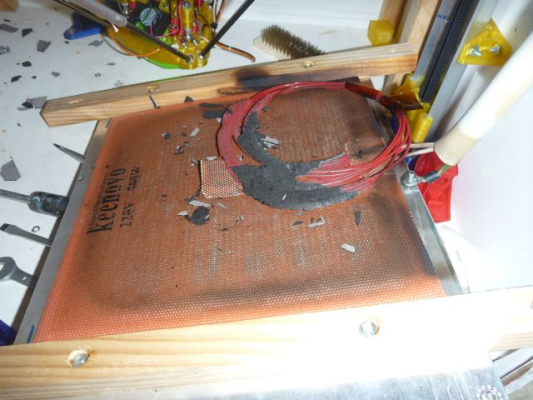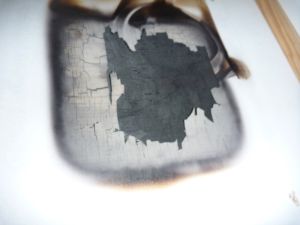Home
>
Safety & Best Practices
>
Topic
The unthinkable: The Tevo Tornado
Posted by PRZ
|
The unthinkable: The Tevo Tornado January 21, 2018 06:34AM |
Registered: 8 years ago Posts: 475 |
On the 3D printer Tevo ‘Tornado’, a clone of the Creality CR-10, the bed is powered directly by the mains AC ,110/230V. The high power of such bed is appealing but:
The Tevo Tornado are printers with a Y moving bed, so bed power supply cables are submitted to intense stress and it is unavoidable that cables break or detach. Indeed, the CR-10 is notorious for the break of its bed cables, notably due to poor engineering on cable anchoring. But on The Tevo Tornado, a cable rupture can send deadly voltage on your WHOLE printer.
A bed heater powered by the mains shall NEVER be installed on a 3D printer with a moving bed and this is in fact the very first time I see that.
Among the first builders to use bed powered by the mains AC were delta user. On deltas, the bed is static, so it is reasonably easy to secure wiring, but vibrations shall always be taken into account. On machines were the bed is only moving in Z (Ultimaker type or CoreXY), this is a bit more complex, but the cycling is comparatively thousand times lower than on Y moving bed machines. Again, vibrations and small movement (Z hop) shall be taken into account.
This Y moving bed in 110/230V is a technical first, from a Chinese manufacturer who built machines on the cheapest possible way. And we already know that problems occurs with low voltage equipment. Raising the voltage from 12/24V to 110/230V is transforming a serious problem in a deadly one.
These manufacturers sell directly from China, they do know they cannot be sued, why will they care about your safety?
In industry, it does exist special cables for robots which can handle millions movement cycles safely. But you probably could buy a complete Chinese printer for the price of such cable. And their installation are properly engineered.
In addition, these machines haven’t double electrical insulation, so everything shall be earthed, when the cable will broke (it WILL).
But what we see on the un-boxing videos is stunning: 1 2 3
I bet this is not done as connecting the power supply output negative to earth may drive to problems with the USB connection, creating what is called earth loops
In short, as for most printers directly imported from China, there is no compliance with basic safety rules…
The CR-10 was carrying significant improvements in safety among the Chinese printers. With a metallic enclosure around its power supply and electronic, proper wiring with terminals, it was much better than was commonly coming from China. But with The Tevo Tornado, we are back to safety insanity.
And you find Youtube ‘reviewers’ whose main complaint is that there are no tips at the end of the aluminum profiles. What a sense of priority!
You may think that using the mains AC reduce the fire hazard created by insufficiently rated MOSFET, terminals, printed circuit tracks or bed wires, and that you are trading fire hazard for electric risk. What did you prefer ?
If you think that, I invite you to think twice:
I got a serious trouble with one of these Silicon heating pad, - Yes, this is not a second hand report, it occurred to ME -
I tested as a chamber heater a silicon pad glued on an aluminum plate, 3mm thick. Not very different from a bed heater, only it was installed vertically to have a better heat transfer and cooled on both sides, as it was a radiator. For unknown reason (voltage was compliant AND I checked the resistance), at full power this pad inflated like a cushion, with significant pressure in, so the heating elements, having no longer any thermal mass to heat, also were no longer cooled as the inflation closed the cooling air gap, raised to a temperature sufficient to burn the wood panel aside it and now in close contact due to the inflation. Have a look at the photo, the wire insulation state will give you an idea of the high cushion pressure and temperature.
I have no idea why it did inflated, chemicals which gasified in the bed, hot spot or short which also drive to gasification, the only important point is that totally unexpected event did occurred.
The Emergency Shutdown Button (red mushroom type) I had installed did find its first (and unique) use.
So, if your printer is installed on a nice granite kitchen counter, you may be immune to that sort of problem, but on a wooden desk, you just created a new type of fire hazard associated with 3D printer.
The licence of this post is CC0, including photos so please don’t hesitate to spread it.
[edit]
It seems that somes feels also concerned (that's in German, but google translation is quite decent)
While others are denying there are problems
Edited 4 time(s). Last edit at 01/21/2018 03:27PM by PRZ.
Pierre
- Safety [reprap.org]
- Embedded help system for Duet and RepRap Firmware [forums.reprap.org]
- Enclosed delta printers Lily [rouzeau.net] and Lily Big [rouzeau.net]
- OpenScad delta printer simulator [github.com]
- 3D printing on my site [www.rouzeau.net]
The Tevo Tornado are printers with a Y moving bed, so bed power supply cables are submitted to intense stress and it is unavoidable that cables break or detach. Indeed, the CR-10 is notorious for the break of its bed cables, notably due to poor engineering on cable anchoring. But on The Tevo Tornado, a cable rupture can send deadly voltage on your WHOLE printer.
A bed heater powered by the mains shall NEVER be installed on a 3D printer with a moving bed and this is in fact the very first time I see that.
Among the first builders to use bed powered by the mains AC were delta user. On deltas, the bed is static, so it is reasonably easy to secure wiring, but vibrations shall always be taken into account. On machines were the bed is only moving in Z (Ultimaker type or CoreXY), this is a bit more complex, but the cycling is comparatively thousand times lower than on Y moving bed machines. Again, vibrations and small movement (Z hop) shall be taken into account.
This Y moving bed in 110/230V is a technical first, from a Chinese manufacturer who built machines on the cheapest possible way. And we already know that problems occurs with low voltage equipment. Raising the voltage from 12/24V to 110/230V is transforming a serious problem in a deadly one.
These manufacturers sell directly from China, they do know they cannot be sued, why will they care about your safety?
In industry, it does exist special cables for robots which can handle millions movement cycles safely. But you probably could buy a complete Chinese printer for the price of such cable. And their installation are properly engineered.
In addition, these machines haven’t double electrical insulation, so everything shall be earthed, when the cable will broke (it WILL).
But what we see on the un-boxing videos is stunning: 1 2 3
-
The bed is not earthedbed is in glass, so no need for earthing - The bed support is not earthed
- The printer frame is not earthed
- The thermistor wires are in the same sheath as the bed power supply in 230V !
- The bed wires are not properly secured
- The bed wire sheath is not secured (on both ends)
- There is no Emergency Shutdown Pushbutton (ESD: required when there is a risk in a machine: A printer is machinery and not an appliance and obey to machinery rules)
I bet this is not done as connecting the power supply output negative to earth may drive to problems with the USB connection, creating what is called earth loops
In short, as for most printers directly imported from China, there is no compliance with basic safety rules…
The CR-10 was carrying significant improvements in safety among the Chinese printers. With a metallic enclosure around its power supply and electronic, proper wiring with terminals, it was much better than was commonly coming from China. But with The Tevo Tornado, we are back to safety insanity.
And you find Youtube ‘reviewers’ whose main complaint is that there are no tips at the end of the aluminum profiles. What a sense of priority!
You may think that using the mains AC reduce the fire hazard created by insufficiently rated MOSFET, terminals, printed circuit tracks or bed wires, and that you are trading fire hazard for electric risk. What did you prefer ?
If you think that, I invite you to think twice:
I got a serious trouble with one of these Silicon heating pad, - Yes, this is not a second hand report, it occurred to ME -
I tested as a chamber heater a silicon pad glued on an aluminum plate, 3mm thick. Not very different from a bed heater, only it was installed vertically to have a better heat transfer and cooled on both sides, as it was a radiator. For unknown reason (voltage was compliant AND I checked the resistance), at full power this pad inflated like a cushion, with significant pressure in, so the heating elements, having no longer any thermal mass to heat, also were no longer cooled as the inflation closed the cooling air gap, raised to a temperature sufficient to burn the wood panel aside it and now in close contact due to the inflation. Have a look at the photo, the wire insulation state will give you an idea of the high cushion pressure and temperature.
I have no idea why it did inflated, chemicals which gasified in the bed, hot spot or short which also drive to gasification, the only important point is that totally unexpected event did occurred.
The Emergency Shutdown Button (red mushroom type) I had installed did find its first (and unique) use.
So, if your printer is installed on a nice granite kitchen counter, you may be immune to that sort of problem, but on a wooden desk, you just created a new type of fire hazard associated with 3D printer.
The licence of this post is CC0, including photos so please don’t hesitate to spread it.
[edit]
It seems that somes feels also concerned (that's in German, but google translation is quite decent)
While others are denying there are problems
Edited 4 time(s). Last edit at 01/21/2018 03:27PM by PRZ.
Pierre
- Safety [reprap.org]
- Embedded help system for Duet and RepRap Firmware [forums.reprap.org]
- Enclosed delta printers Lily [rouzeau.net] and Lily Big [rouzeau.net]
- OpenScad delta printer simulator [github.com]
- 3D printing on my site [www.rouzeau.net]
|
Re: The unthinkable: The Tevo Tornado October 24, 2020 11:03PM |
Registered: 4 years ago Posts: 3 |
Sorry, only registered users may post in this forum.

